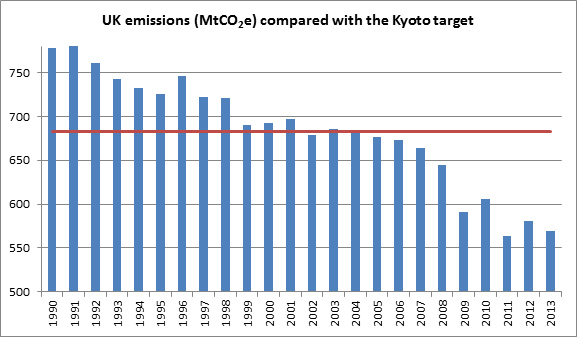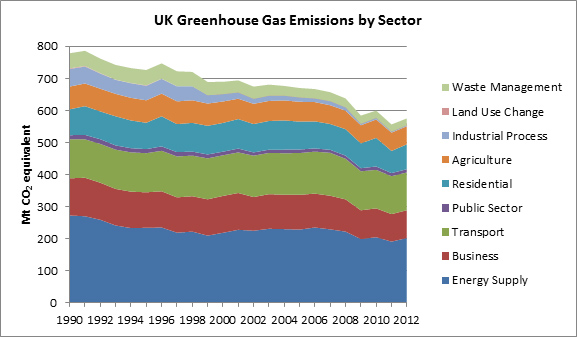How well is the UK doing in cutting its emissions?
The 2008 Climate Change Act introduced an ambitious legally binding commitment to reduce the UK’s greenhouse gas emissions by at least 80% by 2050, relative to 1990. To put the country on the path to this long-term goal, a system of carbon budgets was introduced to limit emissions in successive five-year periods. Budgets have been fixed up until 2027 (known as the fourth carbon budget), which requires the average annual emissions over 2023 to 2027 to be 50% below 1990 levels.
So far, the UK has made good initial progress, at least in meeting its first carbon budget. Counting all the gases covered by the Kyoto Protocol, the country’s annual emissions fell by 25.5% between 1990 and 2012 – substantially more than the 12.5% reduction required under Kyoto on average over 2008–2012 (see chart). By 2013, UK emissions were 28% below their 1990 level, at 2,952 MtCO2e, compared with the legislated budget of 3,018 MTCO2e. The UK’s reduction also compares well with cuts achieved in other countries. According to WRI data, UK emissions fell by an average of 1.5% a year from 1990 to 2011 (the latest year for which data on the main greenhouse gases are available for many countries). That’s far more than most nations. On average, emissions fell by 0.9% a year in the European Union (EU-27) in the same period. Developed countries together decreased their emissions by 0.4% a year and the world as a whole saw an increase of 1.5% a year, with much greater rises in emerging economies such as China (6%) and India (4%). As Globe International has shown, the UK has been a global leader on climate change policy action, but it is not alone.
Source: DECC; data for 2013 are provisional
However, these figures don’t tell the whole story. Most fundamentally, the UK is heavily and increasingly reliant on imported goods from China and other countries where emissions are rising. That doesn’t affect the official emissions figures, which are based on the location of production, though studies have shown that the UK’s total carbon footprint – including the greenhouse gases emitted during the production of imports – was higher recently than it was in 1990.
Furthermore, many of the emissions cuts achieved within the UK to date were the result not of deliberate climate-change policies. For instance, UK emissions fell by almost 7% in 2011 because of a warm winter and Sizewell B nuclear plant in Suffolk producing electricity once more after a period of maintenance. Other unrelated factors include the shift from coal to gas for power generation from the early 1990s and the economic slowdown starting in 2008. Indeed, the government’s independent Committee on Climate Change note that the first carbon budget was met not just because of low-carbon policies but also the recession. Their latest analysis shows that the climate policies introduced so far will not be sufficient to keep UK emissions falling in line with its longer-term carbon budget targets. As the chart below suggests, it has proved particularly difficult to reduce emissions from residential energy use and the transport sector. Policy progress is particularly lacking in energy efficiency improvements (for industry and commercial sectors) and there remains a need to increase usage of electric cars and heat pumps, and to demonstrate carbon capture and storage (CCS) technologies to help reduce emissions.
Source: DECC
Just last month, the CCC observed that the UK’s pace of emission reduction is still insufficient if it is to meet its future carbon budgets. Having recently advised the UK government not to revise the emission reduction targets in the fourth carbon budgets, the CCC conclude “that if there were no further progress, then we would expect a significant shortfall in emissions reduction compared to the fourth carbon budget”. Even if the government delivers its existing emission reduction policies in full, in 2025 emissions could be 44% below 1990 levels, rather than the 50% required by the fourth carbon budget. There remains a clear policy gap between the targets set in the fourth carbon budget and the actual emission reduction progress made to date. The Committee on Climate Change note “the cost of closing this gap is affordable” but that “achieving this will require further strengthening of policies – including those for residential and commercial energy efficiency, electrification of heat and transport and power sector decarbonisation”.
This article was written by Alex Bowen and is a reproduction of the following article “How well is the UK doing in cutting its emissions?”© 2014, The Guardian, used under a Creative Commons No Derivative Works licence.



